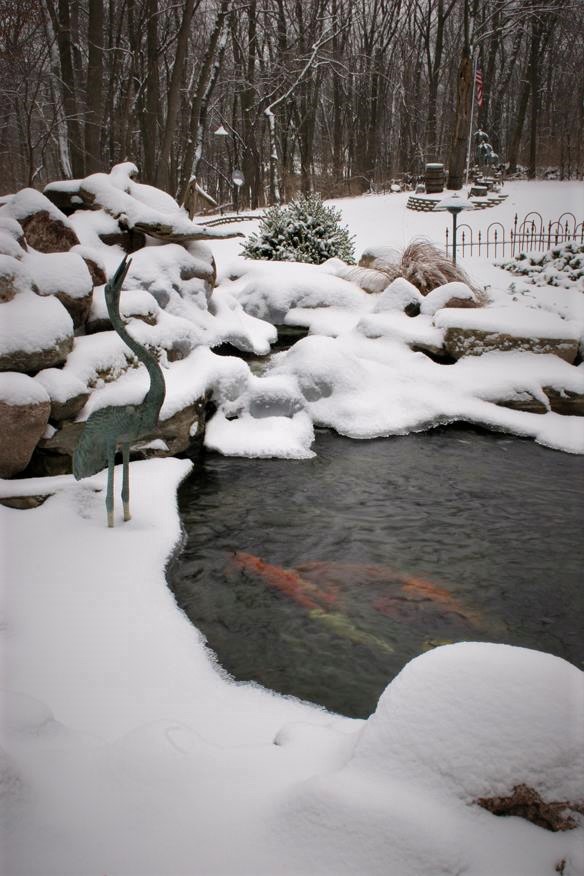Silvery ice formations and velvety white drifts of snow create a dreamy landscape with a winter water feature as the focal point. If you’re like most people, you shut down your water feature for the winter season. While this is a perfectly viable option for most people, some of you opt to keep your water feature running. To ensure that your pond and waterfall provide all the pleasures of a winter wonderland, be sure to follow our handy winter pond keeping tips.

1. Check for Ice Dams
If you keep your pond running during the frozen months of winter, you’ll enjoy the beautiful ice sculptures that form in the stream and waterfall. Although stunning, it’s possible that the ice buildup can form dams that could divert your pond water out of the pond. Check on the waterfall and stream and monitor the water level periodically throughout the winter. If you see an ice dam forming or the water level dropping at a high rate, your pond might be losing water because of the frozen sculpture and it might be time to turn off the pump for the winter. If you decide to leave the pond running until warmer weather however, your main concern is to ensure there is enough water for the pump(s) to operate properly.
2. Add Water to Your Pond
During the winter months, the usual water supply options are not available. Outdoor water spigots and automatic water fill valves should be turned off to prevent pipes from freezing and cracking. Therefore, pond owners who run their systems during the winter will have to find an alternate water source to replenish their pond. Water can be supplied via a hose run from inside the house or by making multiple trips with a large bucket. Generally speaking, it’s not uncommon to have to go out a few times a month during the winter to “top off” the pond.
3. Check the Circulation of Water
Pump size is important when determining a waterfall’s ability to operate during the winter. A pump that provides at least 2,000 gph can be operated throughout the winter without a problem, as long as it runs continuously. Moving water will usually keep a hole open in the ice around the waterfalls and in front of the circulation system. However, repeated days in sub-zero temperatures may lead to excessive ice build-up. You can add a pond de-icer to help keep a hole in the ice, or incorporate a submersible pond pump such as the AquaForce Pump or the Pond Powerhead. Both provide agitation at the surface of the pond to keep a hole open.
4. Be Assured of Filters and Pipes
Most good filters are constructed out of rotational-molded polyethylene, and are designed to bow and bend with the freezing and thawing effects of winter. The PVC flex pipe is reinforced and will also not crack unless water is left in the pipe over the winter and allowed to freeze. If you decide to keep the pump running all winter long, there will still be a constant flow of water traveling through the pipe, and the moving water will not freeze.
5. The Bottom Line for Winter Pond Keeping
The bottom line for winter pond keeping is maintenance. Roughly 70 percent of pond owners in the colder climates decide to shut down their system because they don’t enjoy tending to their water garden during the bitter months of the winter. The aesthetic rewards of the winter pond are absolutely worthwhile, so by all means; don’t be afraid to keep the system running as long as possible. Shutting down a pond during winter is also an option. Just be sure you take precautionary measures to preserve fish, plant, and pump life.

